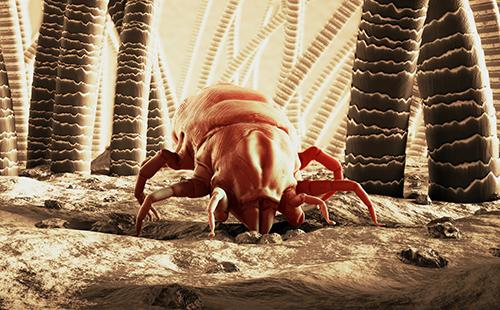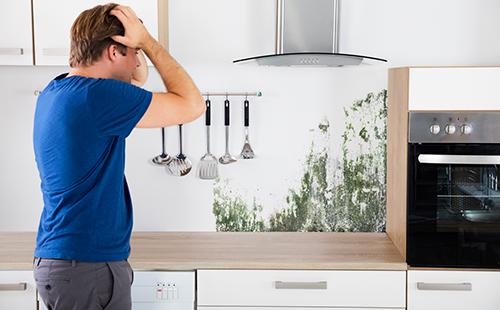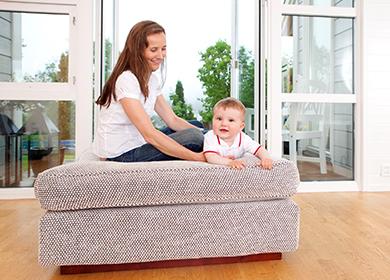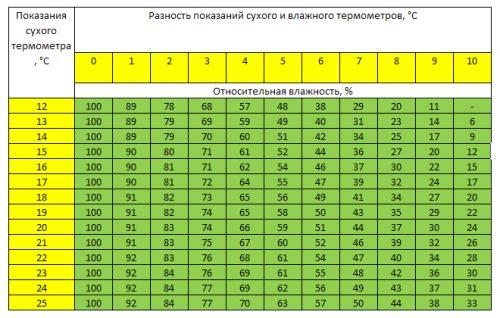The content of the article
The degree of humidity depends on the season, weather conditions and regional climate - these factors determine the optimal air environment as a separate region, and a particular room. In winter, humidity decreases markedly, and in summer it becomes higher. Not only people's health and well-being, but also the state of surrounding objects depends on air quality. Indoor plants, furniture, books, parquet, wallpaper, appliances and other elements of the interior do not tolerate humidity changes and can become unusable over time.
What ideal and favorable humidity should be in the apartment
Normative indicators of permissible moisture in residential buildings in the Russian Federation are prescribed by GOST and depend on both the purpose of the rooms and seasonality.
- Summer. In summer, the moisture level in the air should vary from 30 to 60%, but not exceed 70%.
- Winter. In the cold period, the permissible value is 30-45%, the maximum is 60%.
Standards for individual rooms. How much% humidity should be kept indoors
The previous figures show that in winter the moisture level in the apartment is lower than in summer. Low humidity is due to the fact that the humidity of the cold street air entering the room decreases when heated to room temperature. However, in the heating season, the human body needs no less moisture than in summer, so doctors recommend keeping the humidity in the house at 40-60%, regardless of the season of the year.
- Bedroom. For a comfortable state of health and healthy sleep in bedrooms, the optimum degree of humidity should be in the range of 40-55%. Try to get rid of excess equipment as much as possible and ventilate the room as often as possible. To strengthen immunity, doctors advise you to sleep with an ajar window, even in the off-season or in winter.
- Children. Children quickly overheat and freeze, are susceptible to infections and more difficult to tolerate diseases. Therefore, for the child you need to maintain the right microclimate. Dry air overdries the mucous membrane of the nasopharynx, provoking colds: runny nose, cough, bronchitis. The lack of moisture for the newborn is extremely dangerous - peeling and atopic dermatitis can form on delicate skin. The norm of air humidity in the apartment where the baby lives is 50-60%.
- Living room. The largest and most spacious room in the house where all members of the family spend most of the time. From 40 to 50% - this level of humidity will become comfortable not only for people, but also for pets, indoor flowers, as well as household appliances and furniture.
- Kitchen, bathroom. Here the humidity level usually goes beyond the permissible norms.Cooking and water treatments significantly increase temperature and moisture. Good ventilation will help to solve the problem. If the hood does not function well, install an additional fan in it and ventilate the rooms more often, trying to achieve humidity indicators in the living room - 40-50%.
- Study. 30-40% - a sufficient level of moisture in the air for a home office or library. Higher rates can adversely affect books, documents, equipment. Typically, the air in the cabinets is dry, so a common task for the work area is to increase the humidity in the room.
- Greenhouse. If you are a happy owner of a winter garden in the house, remember that, in addition to good lighting and temperature conditions, you should provide the plants with the necessary moisture dose at the level of 50-70%, depending on the origin of the plants.
The table indicates what relative humidity is considered normal in the apartment for each individual room at the optimum temperature.
Table - Optimum humidity and temperature parameters for individual rooms
| Room | Air temperature ° C | Air humidity,% |
|---|---|---|
| Bedroom | 16-20 | 40-55 |
| Children | 18-24 | 50-60 |
| Living room | 18-23 | 40-50 |
| Kitchen | 19-22 | 40-50 |
| Bathroom | 21-23 | 40-50 |
| Restroom | 16-19 | 40-45 |
| Study | 18-22 | 30-40 |
| Hallway | 18-19 | 40-45 |
| Greenhouse | 16-25 | 50-70 |
How to measure: 4 ways
How to find out the air humidity in the house and increase it, if necessary - there are four proven methods for this. The most reliable will be the use of a hygrometer - a reliable instrument for measuring indoor air humidity. How is air humidity measured in an apartment when there is no hygrometer? By improvised means. Of course, they will not produce accurate digital data, but in general they will determine whether drying or additional humidification is necessary for the air in the home.
- Hygrometer. This device is easy to use, quickly show the exact and absolute temperature and percentage of moisture in the atmosphere. There are several types of devices: psychrometric, electronic, mechanical, condensation, hair and weight. The most convenient and accurate, according to users, is an electronic device that can be installed permanently or transferred as needed from one room to another.
- Assman Psychrometric Table. Record temperature readings on a room thermometer. Wrap the mercury instrument head with a wet cloth or cotton swab. After five to ten minutes, write down the result. Subtract the second from the first number of temperature. Then look at the Assman table (see table below). In the vertical left column find the first reading of the thermometer, in the horizontal top line - the second calculation. At the intersection of numbers you will see the approximate moisture level in your room.
- Glass of water. For two to three hours, place a glass of water in the refrigerator, cooling the liquid to 3-5 ° C. At room temperature, observe the reaction of water on the outside of the vessel for several minutes. If in five to ten minutes the glass walls managed to fog and dry, this indicates an overdried air. The glass continues to become foggy - the humidity in the room is average, in the case when the condensate drains in large drops - this is an indicator of too high humidity.
- Fir cone. Leave the cone ate for several hours in a room away from heat sources. In a dry atmosphere, the scales will open, with an increased degree of moisture, they will tightly compress.
How to increase
In winter, the indoor air is dried due to heating, in summer the air condition dries the atmosphere, because of this the humidity is low and needs to be raised. How to humidify the air in a room - special devices or time-tested folk remedies will solve the problem.
Humidifiers
The modern market offers three types of humidifiers, the principle of which is to evaporate water from a special tank and supply the missing moisture to the airspace.
- Mechanical (traditional). It functions due to the built-in fan inside, which drives air through a tray with liquid, cleansing of dust particles and moisturizing. The “minus” of the device is a high degree of noise during operation and a limited level of humidification - up to a maximum of 60%.
- Steam. The principle of operation resembles a kettle, from which boiled water enters the atmosphere in the form of steam. Hard water is allowed - directly from the tap. However, the device is also noisy in the operating mode, consumes a lot of electricity and requires increased care in use - hot steam can leave a burn on the skin or damage the surfaces of nearby objects.
- Ultrasonic. Turns water into a vapor state thanks to a special membrane plate. It is not as noisy at work as the first two models. The fluid heating function is capable of killing pathogenic microbes in the atmosphere. Pour into the tank of such a device only distilled water or buy cartridges to clean and soften it.
Home methods
The absence of a vapor-generating apparatus at home is not a sentence. The following three "grandfather" methods will help saturate the room with the missing moisture without a humidifier.
- Water tank. Place water containers near radiators or on top of batteries, as well as cabinets or bedside tables. Evaporating, water will increase humidity in the air and keep it at the right level. Replenish water in vessels as it evaporates.
- Wet towels. Wet fabric napkins or towels throughout the day and place them on the battery; repeat the procedure when the fabric dries. The task can be simplified as follows: place a container of water under the battery, lowering one end of the bandage tape folded two to three times into it, place the other end on top of the battery. Rising to heat, the liquid will gradually evaporate, solving the problem of dry air.
- Houseplants. Home flowers, by default, give oxygen and moisture to the atmosphere, and regular watering and frequent spraying will improve the indoor climate.

3D visualization of a dust mite that can cause allergies.
Dry air hazard
An atmosphere that is too dry forms static electricity, which picks up and holds fine dust particles in the air. The result is the reproduction of dust mites and other germs that cause health problems.
- Dry mucous membranes. Weakens the immune system, provokes the appearance of infectious and colds, the occurrence of itching, redness and burning eyes.
- Dry skin. The first step is the appearance of dermatitis, peeling, the formation of microcracks and early wrinkles, brittle nails and brittle hair.
- Heart load. It occurs due to a slowdown in blood circulation, the first symptoms are weakness and headache.
- Digestive system. As a result of increasing the viscosity of the digestive juice in the stomach and intestines.
- Air quality deterioration. It entails the formation in the atmosphere of a high concentration of allergens.
How to lower
When the cause of the increased humidity is an external source - a damp basement, a dilapidated roof, or a pond located near the house, the most reliable way is to carry out repairs using waterproofing. If the formation of dampness is the result of your life, then the following methods will help get rid of moisture in the house.
Dehumidifiers
Household dehumidifiers are mobile and stationary. Productivity of the device is measured by the amount of absorption of liters of water per day and varies from 12 to several hundred liters.
- Compressor. The principle of operation of the device is simple: built-in fans drive moist air into the unit and draw it through the evaporator. Due to the temperature difference, moisture settles on it in the form of condensate and flows into a special receiver. Heated air through a separate hole again enters the room.
- Adsorption. Such an apparatus is often called a moisture absorber. The device has no moving parts, does not consume energy and works absolutely silently. The substance absorbs moisture from air adsorbent placed inside the device. The adsorbent saturated with moisture should be periodically changed or a special way to release moisture from it back into the atmosphere.
Home methods
Oil radiators can reduce humidity in an apartment of a small area, modern air conditioners also have the function of adjusting the moisture level in the air. But in order to achieve maximum effect, in addition to using special devices, three simple rules should be followed.
- Ventilation. Regular aeration reduces water vapor in the air. The more often you ventilate, the more the air space in the room dries.
- sunlight. Do not pull the curtains. The sun's rays effectively dry the room in a few hours.
- Cooker hood. In non-ventilated rooms with a high level of moisture, for example, in a toilet or a bathroom, the installation of a quality hood is mandatory. The ventilation system should be equipped with plastic windows in the apartment.

Danger of humid air
Excess water vapor in the airspace of rooms provokes the growth of mold, various fungi and other harmful bacteria, causing a health hazard.
- Chronic diseases. Dampness in a living room provokes the occurrence and severe course of acute respiratory infections, asthma and even tuberculosis. In severe form, these diseases are difficult to cure.
- Fatigue. Stuffy heavy air makes breathing and sleep difficult, and can cause asthma attacks.
- Bad smell. Reproduction of pathogenic microbes causes an unpleasant musty odor in the house, and almost immediately after airing, the feeling of fresh air is lost.
- Damp things. Clothes, towels, linens and other things in a damp room are not completely dried, bacteria multiply on moist tissue, and, in contact with skin, can cause various dermatological diseases.
Regardless of the time of year, do not abuse air conditioners and heaters. Optimal air humidity in an apartment or house is easily achieved due to regular ventilation, wet cleaning. A healthy microclimate in a living room will help to avoid chronic diseases and allergies, positively affecting the well-being of residents. Periodically check the moisture level in the rooms and keep it normal.


